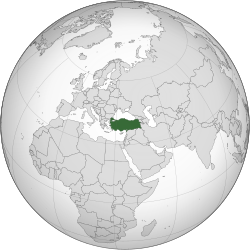თურქეთი
ქიანა აზიას
თურქეთი (Türkiye) — ქიანა აზიას. ტერიტორიაშ დიდ თია მილარე აზიას, შხვა — ევროპას. თურქეთიშ ნანანოღა რე ანკარა. ოფიციალური ნინა თურქეთის რე თურქული ნინა. თურქეთის ოხორანს 74 600 000 კოჩი.
| თურქეთიშ რესპუბლიკა Türkiye Cumhuriyeti თურქეთი |
||||||
|---|---|---|---|---|---|---|
|
||||||
| დევიზი: Yurtta sulh, Cihanda sulh „თინჩალა ქიანას, თინჩალა მოსოფელს” |
||||||
| ჰიმნი: ზოხორინალაშ მარში |
||||||
 |
||||||
| ნანანოღა | ანკარა / | |||||
| უკაბეტაში ნოღა | სტამბოლი | |||||
| ოფიციალური ნინა(ეფი) | თურქული | |||||
| რელიგია | სეკულარული | |||||
| თარობა | საპარლამენტო რესპუბლიკა | |||||
| - | პრეზიდენტი | რეჯეფ თაიფ ერდოღანი | ||||
| - | ვიცე-პრეზიდენტი | ჯევდეთ ილმაზი | ||||
| - | ასამბლეაშ მადუდე | ნუმან ქურთულმუში | ||||
| ფართობი | ||||||
| - | გვალო | 783 356 კმ2 (37-ა) | ||||
| - | წყარი (%) | 1,3 | ||||
| მახორობა | ||||||
| - | 2020 ფასებათ | 83,614,362 (18-ო) | ||||
| - | მეჭედალა | 109 ად/კმ2 (107-ა) | ||||
| ედპ (ჸუპ) | 2021 ფასებათ | |||||
| - | გვალო | $2.749 ტრილიონი (მა-11) | ||||
| - | ართ მახორუშე | $32,278 (მა-68) | ||||
| აგი (2019) | 0.820 (54-ა) | |||||
| ვალუტა | თურქული ლირა (₺) (TRY) |
|||||
| ბორჯიშ ორტყაფუ | FET (UTC+3) | |||||
| Internet TLD | .tr | |||||
| ოტელეფონე კოდი | +90 | |||||
ქიანაშ ჯოხოდვალა
რედაქტირაფა- ოფიციალური — თურქეთიშ რესპუბლიკა;
- ოდაბადური — Türkiye Cumhuriyeti.
ისტორია
რედაქტირაფათურქეთი მილარე ჯვეში ბიზანტიაშ ტერიტორიას. 1299-1923 წანეფს მუშ ტერიტორიას მილარე ოსმალეფიშ იმპერია.
1923 წანაშ უკული თურქეთი რე რესპუბლიკა. მუშ მაართა პრეზიდენტი ორდ მუსტაფა ქემალ ათათურქი
დემოგრაფია
რედაქტირაფათურქეთის ოხორანს 68,1 მლნ კოჩი (2003 წანაშ მუნაჩემეფი). 80% თურქეფი, 18% ქურთეფი.
გალერეა
რედაქტირაფარელიგია
რედაქტირაფათურქეთიშ ოფიციალური რელიგია რე ისლამი.
- დიდი ნოღეფი
- სტამბოლი
- ანკარა
- იზმირი
- ტრაპიზონი
- ზონგულდაკი
- სივასი
- ბურსა
- ადანა
- გაზიანთეფი
- კონია
- ანტალია

